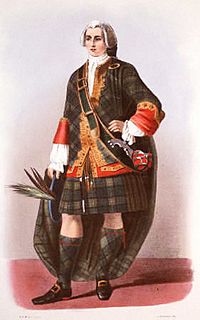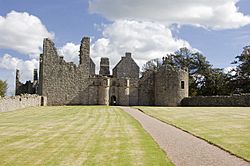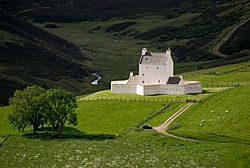Clan Forbes facts for kids
Quick facts for kids Forbes |
|||
|---|---|---|---|
| Foirbeis | |||
| Motto | Grace, me guide. | ||
| War cry | "Lonach" (a hill in Strath Don). | ||
| Profile | |||
| Plant badge | Broom. | ||
| Pipe music | March "Cath Ghlinn Eurainn" ("The Battle of Glen Eurann"). | ||
| Chief | |||
 |
|||
| Lord Malcolm Nigel Forbes | |||
| 23rd Lord Forbes | |||
| Seat | Castle Forbes | ||
| Historic seat | Culloden House | ||
|
|||
|
|||
Clan Forbes is a famous Highland Scottish clan from Aberdeenshire, Scotland.
Contents
History
Early Beginnings
The name Forbes likely comes from the lands of Forbes in Aberdeenshire. The Forbes family has owned these lands since the time of King William the Lion.
One old story says that the "Braes o’ Forbes" (a hilly area) was once full of bears. A brave man named Oconachar, who is said to be the clan's founder, killed the bears. He then claimed the land as his own. The current chief still owns part of these Forbes lands today.
The first person we know of from records was Duncan Forbes. In 1271–72, he received land from King Alexander III of Scotland. Old documents confirm this grant.
Later, in 1306, a John Forbes is mentioned in records. Then, in 1326, a Christian Forbes received land from King Robert the Bruce.
John Forbes, who was the Lord of Forbes, was an important figure. He was the Sheriff of Aberdeen in 1374. He was known as a "good man, wise, and mighty." He died before 1387.
His son, Sir John de Forbes, was called "Sir John of the black lip." He was a judge and official in Aberdeenshire. He had four sons. His younger sons started many other Forbes family lines. Sir John died in 1406.
15th Century Adventures
Sir John Forbes's son, Alexander Forbes, 1st Lord Forbes, fought in the Battle of Harlaw in 1411. This battle was a big fight in Scottish history.
Alexander was allowed to visit King James I of Scotland in France in 1421. He could bring up to one hundred followers with him. He married Elizabeth, whose mother was the daughter of King Robert III of Scotland.
King James I made Alexander Forbes a Baron Forbes between 1444 and 1445. This was a very important title. Alexander Forbes, the 1st Lord Forbes, passed away in 1448.
James, the 2nd Lord Forbes, had three sons. His sons also started new branches of the Forbes family. These included the Forbeses of Corsindae and Monymusk, and the Forbeses who became Lord Sempill.
Alexander, the 4th Lord Forbes, joined his clan to get revenge for the death of King James III of Scotland. However, after a defeat, he joined forces with King James IV of Scotland.
John, the 6th Lord Forbes, was accused of serious crimes against the king in 1536. He was held in Edinburgh Castle but was later found innocent. Sadly, his eldest son, John Forbes, Master of Forbes, was also accused and was executed.
Famous Feuds
In the 16th century, the Clan Forbes had a long and difficult rivalry with the Clan Gordon. This was a time of many conflicts and disagreements between the two clans.
In the 1520s, there were violent events on both sides. One important person killed by the Forbeses was Seton of Meldrum, who was close to the chief of Clan Gordon, the Earl of Huntly.
The Earl of Huntly then became involved in a plan against the Master of Forbes. The Master of Forbes was accused of trying to harm King James V of Scotland. He was sentenced to be executed. However, just a few days later, his conviction was overturned, and the Forbes family was back in the king's favor.
The Protestant Reformation added to the rivalry. The Gordons stayed Catholic, while the Forbeses became Protestant. Other clans chose sides: the Clan Leslie, Clan Irvine, and Clan Seton joined the Gordons. Protestant families like the Clan Keith, Clan Fraser, and Clan Crichton supported the Forbeses.
In 1571, twenty Gordons were killed at a dinner at the Forbeses' Druminnor Castle. Later that year, the rivalry reached its peak with the Battle of Tillieangus and the Battle of Craibstone. Druminnor Castle, the home of the Forbes chief, was attacked and robbed.
The Gordons then carried out a tragic event at Corgarff Castle. They killed twenty-seven Forbeses of Towie, including women and children. It took two special laws from Parliament to make the clans stop fighting.
War Heroes
Alexander, the 10th Lord Forbes, was a high-ranking general. He fought for King Gustavus Adolphus during the Thirty Years' War in Europe. When he came back to Scotland, he was given a job to help stop problems in Ireland. He later moved back to Germany and died in Sweden in 1672.
18th Century Challenges
During the Jacobite risings, the Jacobites tried to take Culloden House. This was the home of Duncan Forbes, Lord Culloden, who strongly supported the British government. This happened in both the Jacobite rising of 1715 and the Jacobite rising of 1745.
In 1724, a report said that Forbes of Culloden had about two hundred men ready to fight. In September 1745, he was asked to create twenty special Independent Highland Companies to fight against the Jacobites. He managed to raise eighteen of these companies.
Family Branches
The Lords Forbes of Pitsligo came from William, the second son of Sir John Forbes. Alexander, the 4th Lord, lost his titles and lands after the Battle of Culloden. He lived secretly for a long time and died in 1762.
The Forbeses, Baronets of Craigievar, are another old family line. They came from Patrick Forbes of Corse, who was an important official for King James III of Scotland. Craigievar Castle was built by this family.
The Forbeses of Tolquhon Castle are a very old branch. They got that estate in 1420. Sir Alexander Forbes of Tolquhon was killed in the Battle of Pinkie Cleugh in 1547. Another William Forbes built the current Tolquhon Castle.
The 10th Forbes laird of Tolquhon helped save King Charles II of England's life at the Battle of Worcester in 1651. The Forbeses sold Tolquhon Castle in 1716 because they lost money in a big business plan called the Darien Scheme.
Sir William Forbes, the 8th Baronet of Craigievar, became Lord Sempill in 1884. He also became the Chief of Clan Sempill.
Tartans
| Tartan image | Notes |
|---|---|
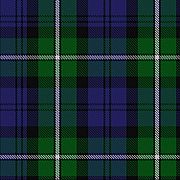 |
Forbes Tartan, Scottish Register of Tartans #1214, Approved by Malcolm, 23rd Lord Forbes, Chief of Clan Forbes. |
Clan Chief
- Clan Chief: Malcolm Forbes, 23rd Lord Forbes and Chief of the Name and Arms of Forbes.
Clan Castles
Many castles have been owned by the Clan Forbes, including:
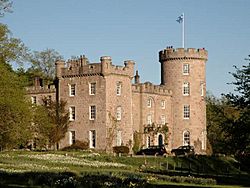
- Castlehill at Druminnor was the first stronghold (a strong fort) on the Forbes lands. The Forbes family held it from 1271 to 1440.
- Druminnor Castle, built by the Forbeses in the 15th century, was changed over time. The Forbeses had many feuds here, including with the Gordons. In 1571, twenty Gordons were killed at a dinner at Druminnor Castle. The Forbes family sold Druminnor Castle in 1770 and moved to Castle Forbes.
- Castle Forbes, near Alford, Aberdeenshire, was once a tower house. It was replaced by a large, castle-like mansion in 1815. This is the current home of the chief of Clan Forbes.
- Craigievar Castle, near Alford, was built by the Forbeses. It's a tall, seven-story tower house. The Mortimer family started building it, but the Forbeses finished it. The National Trust for Scotland now looks after the castle, and you can visit it.
- Tolquhon Castle, near Oldmeldrum, is a ruined castle with a keep and courtyard. The Forbeses got it in 1420 and finished building it. The 10th Forbes laird of Tolquhon helped save King Charles II of England's life in 1651. The Forbeses sold the castle in 1716.
- Corgarff Castle is in a remote area near Ballater. It's a tall, four-story tower house from the 16th century. This castle was the site of a very sad event during the feud between Clan Forbes and Clan Gordon. A group led by Adam Gordon of Auchindoun attacked the castle. It was held by twenty-six women, children, and servants, as the men were away. Margaret Campbell, the wife of Forbes of Towie, refused to give up the castle. Gordon then set the building on fire, and everyone inside was killed.
- Culloden House near Inverness was sold to the Forbeses in 1626. It was the home of Duncan Forbes, Lord Culloden. He supported the British government during the Jacobite rising of 1745. After the Battle of Culloden, many wounded Jacobite prisoners were brought to Culloden House. Lord Culloden later spoke out against the harsh treatment of these prisoners.
See also


